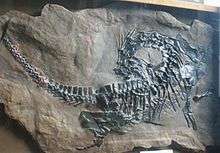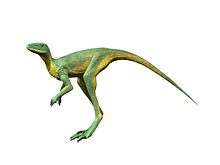Protorosauria
Protorosauria is an extinct, possibly polyphyletic, group of archosauromorph reptiles from the latest Permian (Changhsingian stage) to the early Late Triassic (Carnian stage) of Asia, Europe, North America. It was named by the English anatomist and paleontologist Thomas Henry Huxley in 1871 as an order. Other names which were once considered equivalent to Protorosauria include Prolacertiformes and Prolacertilia.[1]
| Protorosauria | |
|---|---|
 | |
| Fossil specimen of Protorosaurus speneri, Teyler's Museum | |
| Scientific classification | |
| Kingdom: | Animalia |
| Phylum: | Chordata |
| Class: | Reptilia |
| Clade: | Archosauromorpha |
| Order: | †Protorosauria Huxley, 1871 |
| Subtaxa | |
|
†Czatkowiella | |
Protorosaurs are distinguished by their long necks formed by elongated cervical vertebrae, which have ribs that extend backward to the vertebrae behind them. Protorosaurs also have a gap between the quadrate bones and the jugal bones in the back of the skull near the jaw joint, making their skulls resemble those of lizards.[1]
Classification
Protorosauria was considered to be a synonym of Prolacertiformes for many years.[2]
Since 1998, many phylogenetic analyses have found Protorosauria, as used in its widest sense, to be a polyphyletic or paraphyletic taxon. Protorosaurus, Macrocnemus, tanystropheids, and various other protorosaurs are usually placed near the base of Archosauromorpha, while Prolacerta and Pamelaria, two Gondwanan Triassic protorosaurs, are now thought to be in a more derived position as close relatives of Archosauriformes.[3] Most phylogenetic analyses since 1998 have found a strongly supported clade that includes only the genus Prolacerta and the Archosauriformes.[4]
For this reason Prolacerta, Pamelaria, and several other related forms (collectively called prolacertids) have been removed from Protorosauria. Because the name Prolacertiformes is defined based on the genus Prolacerta, the name Protorosauria is used for the remaining group.
Only recently has Protorosauria been defined in a phylogenetic sense as the most inclusive clade containing taxa such as Protorosaurus, Macrocnemus, and Tanystropheus. Analyses, such as Dilkes (1998), Sues (2003), Modesto & Sues (2004), Rieppel, Fraser & Nosotti (2003), Rieppel, Li & Fraser (2008), Gottmann-Quesada and Sander (2009) and Renesto et al. (2010),[4][5][6][7][8] recovered a large Protorosauria, that includes Protorosaurus, Drepanosauridae (and relatives) and Tanystropheidae (and relatives). However, some analysis found Protorosaurus (and sometimes the closely related Czatkowiella) to be more advanced[9] or more basal[10] than the node Drepanosauridae+Tanystropheidae, but always more basal than Prolacerta.
Some studies still use the term Prolacertiformes to include prolacertids and traditional protorosaurs, while restricting the term Protorosauria to the smallest clade that includes Protorosaurus, Macrocnemus, and Tanystropheus; thus Protorosauria is a true clade, while Prolacertiformes is an evolutionary grade of early archosauromorphs.[11]
Pritchard et al. (2015),[12] Nesbitt et al. (2015),[13] and Ezcurra (2016)[14] found that even this definition of Protorosauria, like Prolacertiformes, was an unnatural group of various non-Crocopodan archosauromorphs. These studies found that tanystropheids were archosauromorphs more closely related to crocopods than to Protorosaurus. Nevertheless, Ezcurra noted that archosauromorph systematics required further study, and that phylogenetic support for Protorosauria being a natural group was only barely weaker than the support for the group being unnatural
Included groups
The Protorosauria includes the Permian genus Protorosaurus, closely related to Czatkowiella.[15] A wide variety of Permian and Triassic reptiles have been classified within Protorosauria, including the arboreal gliding reptile Sharovipteryx and the aquatic tanystropheids, which have extremely long necks.
Another enigmatic group of Triassic reptiles, the Drepanosauromorpha, have often been classified as belonging to the Protorosauria.[16]
Pterosaurs have also been proposed as protorosaurs or close relatives of them,[17] although they are now regarded as a more derived group of archosaurs.
While Senter (2004) reassigned the bizarre, arboreal drepanosaurids and Longisquama to a group of more primitive diapsids called Avicephala,[18] subsequent studies failed to find the same result, instead supporting the hypothesis that they were protorosaurs.
Cladogram
The following cladogram shows the position of Protorosauria among the Sauria sensu Sean P. Modesto and Hans-Dieter Sues (2004).[4]
| ||||||||||||||||||||||||||||||||||||||||||||||||||||||||||||||||||||||||||||||||||||||||||||||||||||||||||
References
- Sues, H.-D.; Fraser, N.C. (2010). "Early and early Middle Triassic in Gondwana". Triassic Life on Land: The Great Transition. New York: Columbia University Press. ISBN 9780231135221.
- Benton, M.J.; Allen, J.L. (1997). "Boreopricea from the Lower Triassic of Russia, and the relationships of the prolacertiform reptiles" (PDF). Palaeontology. 40 (4): 931–953.
- Gottmann-Quesada, A.; Sander, P.M. (2009). "A redescription of the early archosauromorph Protorosaurus speneri Meyer, 1832, and its phylogenetic relationships". Palaeontographica Abteilung A. 287 (4–6): 123–200. doi:10.1127/pala/287/2009/123.
- Modesto, S. P.; Sues, H. D. (2004). "The skull of the Early Triassic archosauromorph reptile Prolacerta broomi and its phylogenetic significance". Zoological Journal of the Linnean Society. 140 (3): 335–351. doi:10.1111/j.1096-3642.2003.00102.x.
- David M. Dilkes (1998). "The Early Triassic rhynchosaur Mesosuchus browni and the interrelationships of basal archosauromorph reptiles". Philosophical Transactions of the Royal Society of London, Series B. 353 (1368): 501–541. doi:10.1098/rstb.1998.0225. PMC 1692244.
- Sues, H.-D. (2003). "An unusual new archosauromorph reptile from the Upper Triassic Wolfville Formation of Nova Scotia". Canadian Journal of Earth Sciences. 40 (4): 635–649. Bibcode:2003CaJES..40..635S. doi:10.1139/e02-048.
- Rieppel, O.; Li, C.; Fraser, N. C. (2008). "The skeletal anatomy of the triassic protorosaur Dinocephalosaurus orientalis Li, from the Middle Triassic of Guizhou Province, southern China". Journal of Vertebrate Paleontology. 28: 95–110. doi:10.1671/0272-4634(2008)28[95:TSAOTT]2.0.CO;2.
- Renesto, Silvio; Spielmann, Justin A.; Lucas, Spencer G.; Tarditi Spagnoli, Giorgio (2010). "The taxonomy and paleobiology of the Late Triassic (Carnian-Norian: Adamanian-Apachean) drepanosaurs (Diapsida: Archosauromorpha: Drepanosauromorpha)". New Mexico Museum of Natural History and Science Bulletin. 46: 1–81.
- Li, C.; Rieppel, O.; Labarbera, M. C. (2004). "A Triassic Aquatic Protorosaur with an Extremely Long Neck". Science. 305 (5692): 1931. doi:10.1126/science.1100498. PMID 15448262.
- Magdalena Borsuk−Białynicka; and Susan E. Evans (2009). "A long−necked archosauromorph from the Early Triassic of Poland" (PDF). Paleontologica Polonica. 65: 203–234.
- Hone, D. W. E.; Benton, M. J. (2007). "An evaluation of the phylogenetic relationships of the pterosaurs among archosauromorph reptiles". Journal of Systematic Palaeontology. 5 (4): 465–469. doi:10.1017/S1477201907002064.
- Pritchard, Adam C.; Turner, Alan H.; Nesbitt, Sterling J.; Irmis, Randall B.; Smith, Nathan D. (2015-03-04). "Late Triassic tanystropheids (Reptilia, Archosauromorpha) from northern New Mexico (Petrified Forest Member, Chinle Formation) and the biogeography, functional morphology, and evolution of Tanystropheidae". Journal of Vertebrate Paleontology. 35 (2): e911186. doi:10.1080/02724634.2014.911186. ISSN 0272-4634.
- J., Nesbitt, Sterling; 1955-, Flynn, John J. (John Joseph); 1987-, Pritchard, Adam C.; 1953-, Parrish, J. Michael; Lovasoa., Ranivoharimanana; R., Wyss, André (2015-12-07). "Postcranial osteology of Azendohsaurus madagaskarensis (?Middle to Upper Triassic, Isalo Group, Madagascar) and its systematic position among stem archosaur reptiles. (Bulletin of the American Museum of Natural History, no. 398)". hdl:2246/6624. Cite journal requires
|journal=(help)CS1 maint: numeric names: authors list (link) - Ezcurra, Martín D. (2016-04-28). "The phylogenetic relationships of basal archosauromorphs, with an emphasis on the systematics of proterosuchian archosauriforms". PeerJ. 4: e1778. doi:10.7717/peerj.1778. ISSN 2167-8359. PMC 4860341. PMID 27162705.
- Borsuk–Białynicka, M.; Evans, S.E. (2009). "A long–necked archosauromorph from the Early Triassic of Poland" (PDF). Palaeontologia Polonica. 65: 203–234.
- Renesto, S (1994). "Megalancosaurus, a possibly arboreal archosauromorph (Reptilia) from the Upper Triassic of northern Italy". Journal of Vertebrate Paleontology. 14 (1): 38–52. doi:10.1080/02724634.1994.10011537.
- Peters, D (2000). "A Redescription of Four Prolacertiform Genera and Implications for Pterosaur Phylogenesis". Rivista Italiana di Paleontologia e Stratigrafia. 106 (3): 293–336.
- Senter, P (2004). "Phylogeny of Drepanosauridae (Reptilia: Diapsida)". Journal of Systematic Palaeontology. 2 (3): 257–268. doi:10.1017/S1477201904001427.









